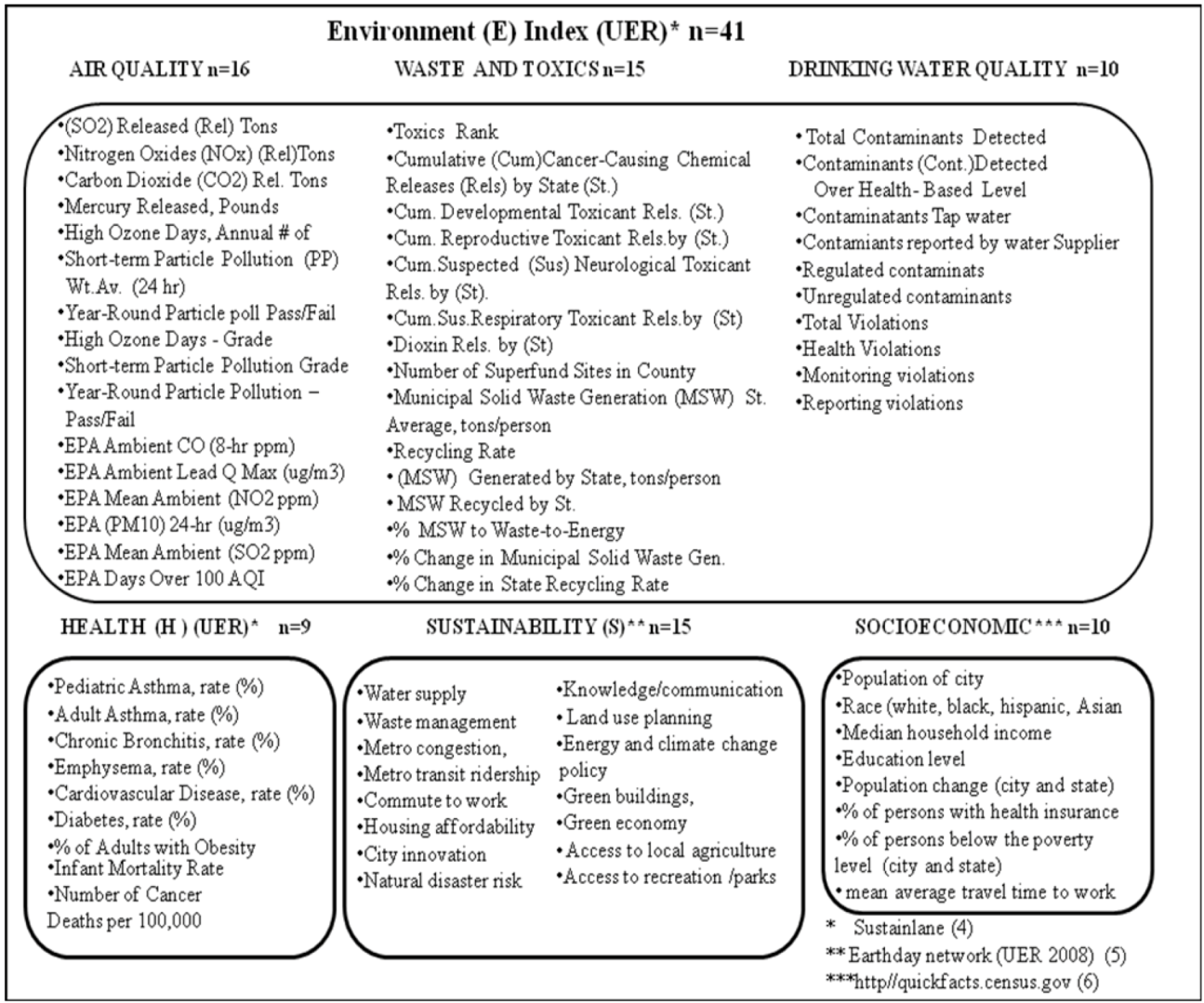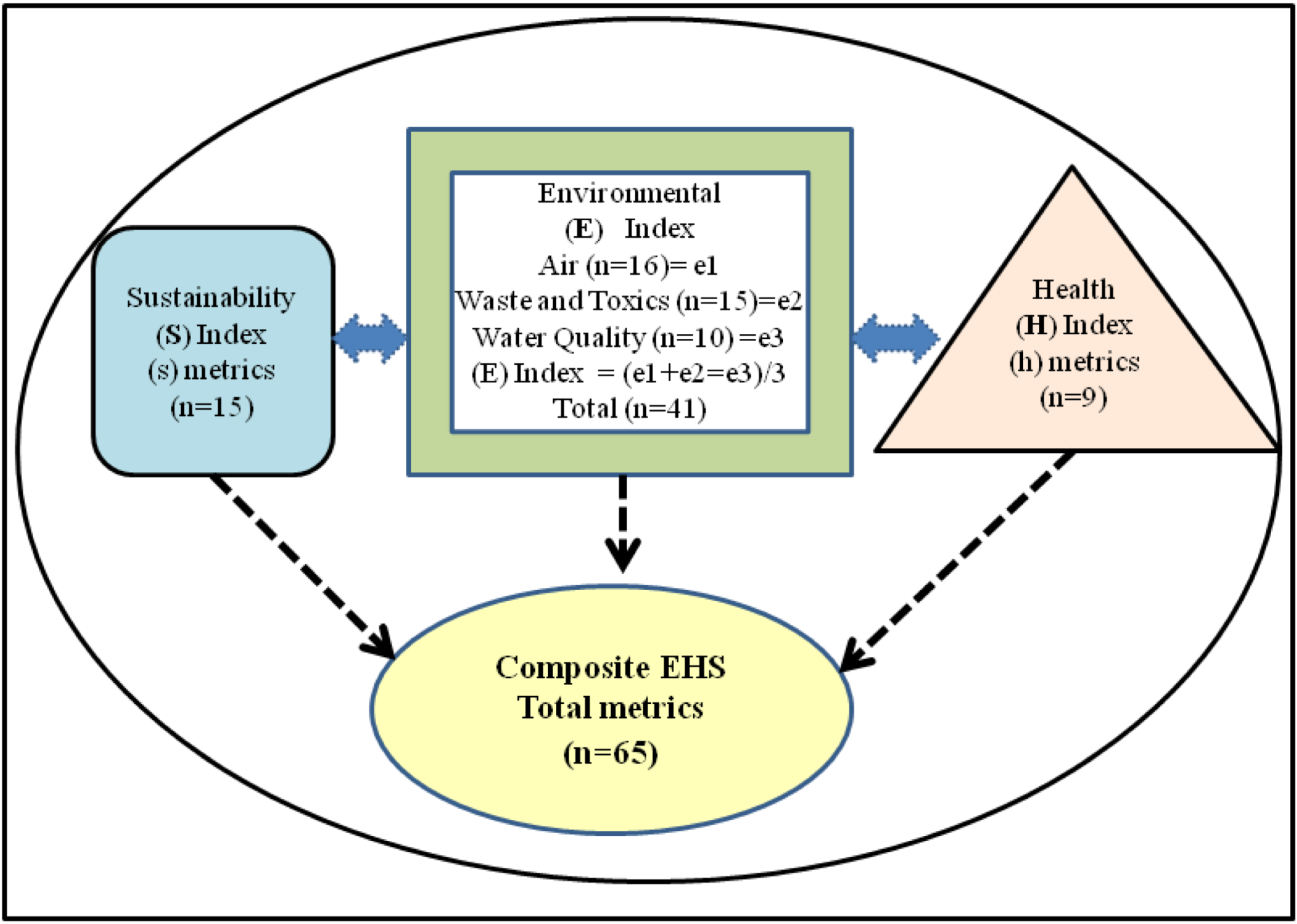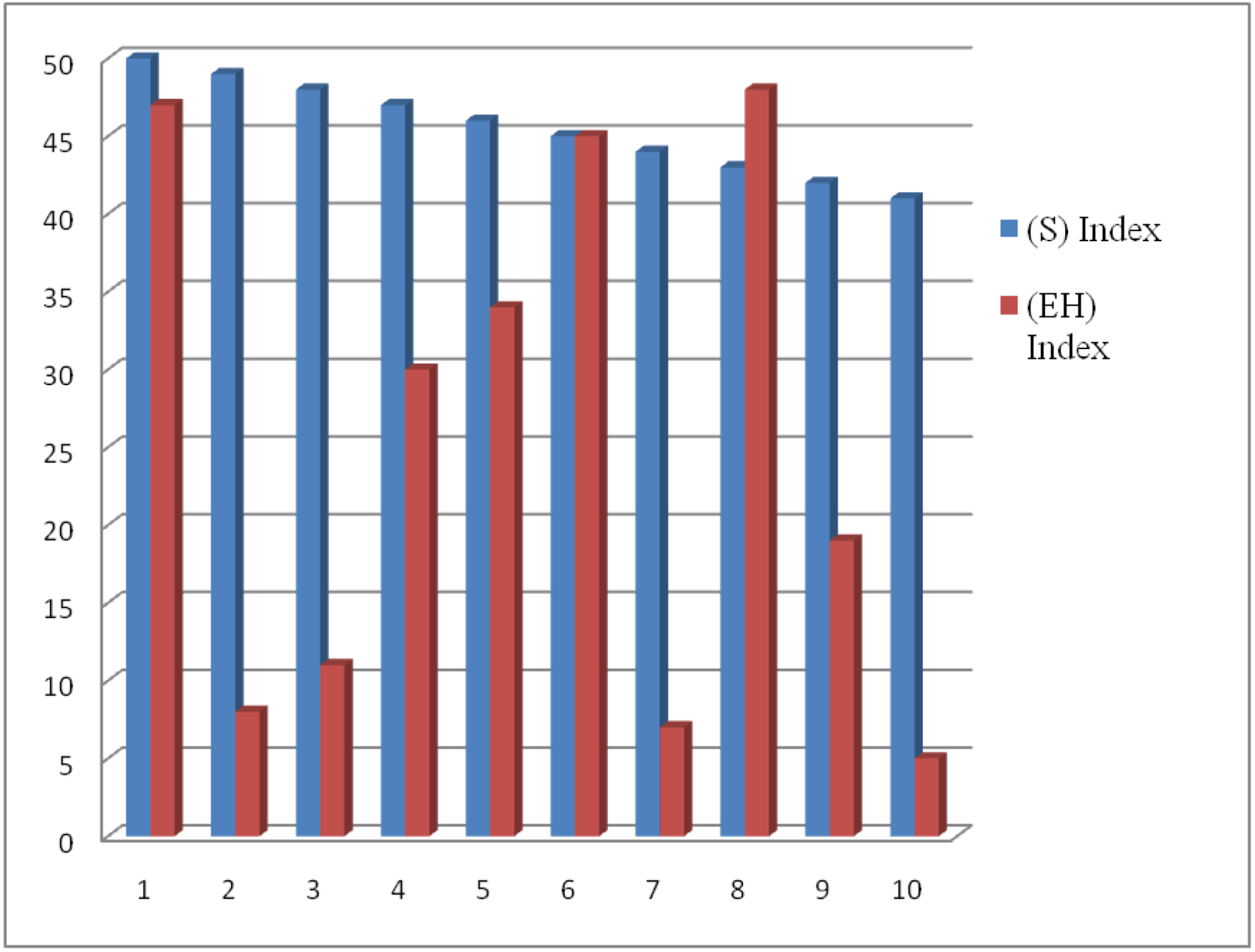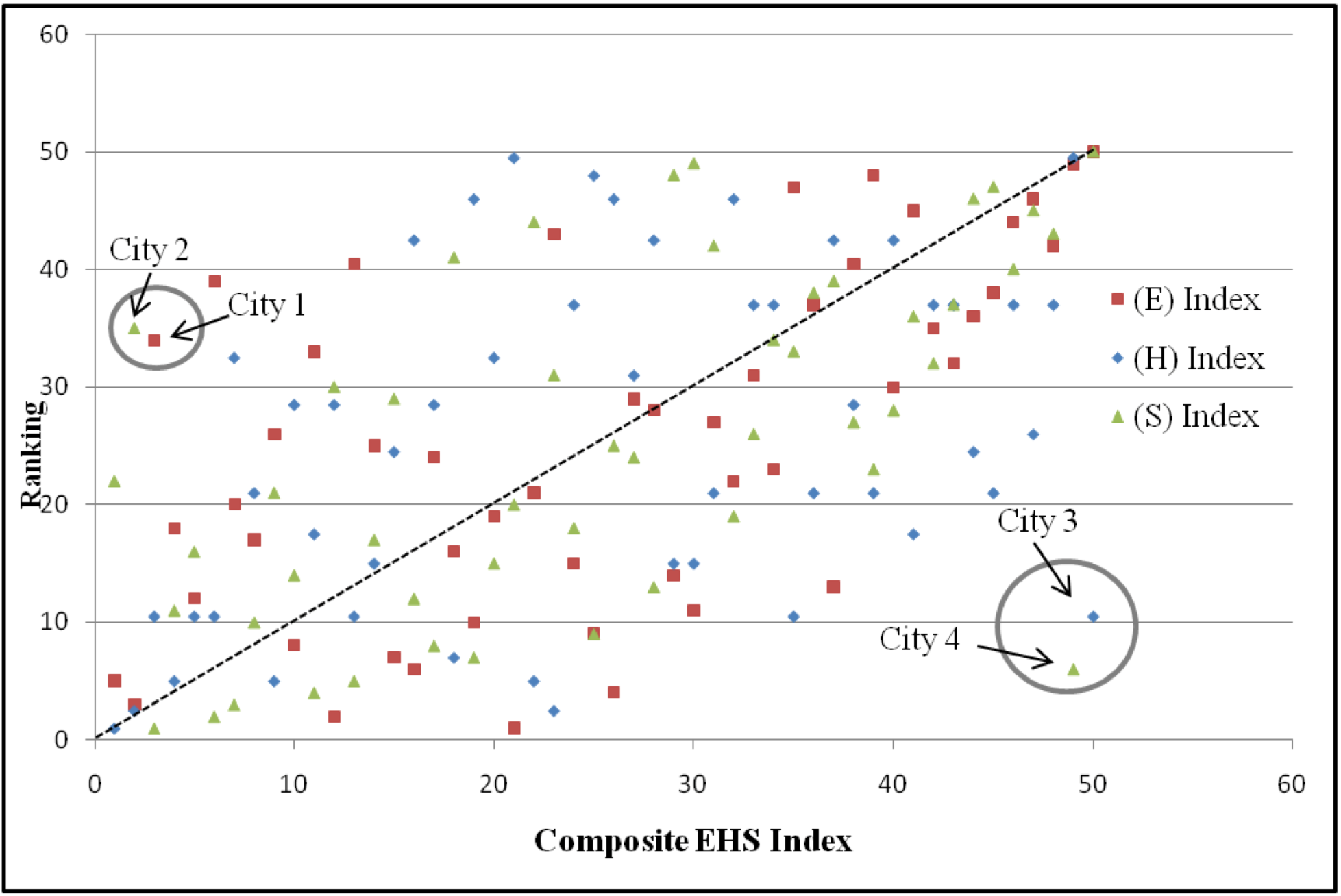Sustainability, Health and Environmental Metrics: Impact on Ranking and Associations with Socioeconomic Measures for 50 U.S. Cities
Abstract
:1. Introduction
1.1. Comparative Rankings: A Convenient Assessment Tool
2. Methods
| City | Population (2010) | City | Population (2010) |
|---|---|---|---|
| Albuquerque, NM | 545,852 | Memphis, TN | 646,889 |
| Arlington, TX | 365,438 | Mesa, AZ | 439,041 |
| Atlanta, GA | 420,003 | Miami, FL | 399,457 |
| Austin, TX | 790,390 | Milwaukee, WI | 594,833 |
| Baltimore, MD | 620,961 | Minneapolis, MN | 382,578 |
| Boston, MA | 617,594 | Nashville, TN | 601,222 |
| Charlotte, NC | 731,424 | New Orleans, LA | 343,829 |
| Chicago, IL | 2,695,598 | New York, NY | 8,175,133 |
| Cleveland, OH | 396,815 | Oakland, CA | 390,724 |
| Colorado Springs, CO | 416,427 | Oklahoma City, OK | 579,999 |
| Columbus, OH | 787,033 | Omaha, NE | 408,958 |
| Dallas, TX | 1,197,816 | Philadelphia, PA | 1,526,006 |
| Denver, CO | 600,158 | Phoenix, AZ | 1,445,632 |
| Detroit, Mi | 713,777 | Portland, OR | 583,776 |
| El Paso, TX | 649,121 | Sacramento, CA | 466,488 |
| Fort Worth, TX | 741,206 | San Antonio, TX | 1,327,407 |
| Fresno, CA | 494,665 | San Diego, CA | 1,307,402 |
| Honolulu, HI* | 337,256 | San Francisco, CA | 805,235 |
| Houston, TX | 2,099,451 | San Jose, CA | 945,942 |
| Indianapolis, IN | 820,445 | Seattle, WA | 608,660 |
| Jacksonville, FL | 821,784 | Tucson, AZ | 520,116 |
| Kansas City, MO | 459,787 | Tulsa, OK | 391,906 |
| Las Vegas, NV | 583,756 | Virginia Beach, VA | 437,994 |
| Long Beach, CA | 462,257 | Washington, DC | 601,723 |
| Los Angeles, CA | 3,792,621 | ||
| Louisville, KY | 597,337 | Total | 46,689,922 |


2.1. Derivation of E and H and S Indices
2.2. Normalization of the Scoring/Ranking and Derivation of the Integrated EHS Index
 where Φ represents the cumulative normal distribution function; N = number of values that were ranked. Among groups of cities with the same variable value (i.e., ties), we calculated the average Z and assigned it to each city in the group. For each E, H and S Index, the mean of all normalized variables contributing to the Index was then itself normalized to create the final E, H, S Indices. Finally the integrated EHS Index was derived from E and H and S indices using the following formula;
where Φ represents the cumulative normal distribution function; N = number of values that were ranked. Among groups of cities with the same variable value (i.e., ties), we calculated the average Z and assigned it to each city in the group. For each E, H and S Index, the mean of all normalized variables contributing to the Index was then itself normalized to create the final E, H, S Indices. Finally the integrated EHS Index was derived from E and H and S indices using the following formula;

3. Results
3.1. Descriptive Statistics
| Mean | Std Deviation | CV (%) | Min | Max | |
|---|---|---|---|---|---|
| Population | 933,798 | 1,217,460 | 130.3 | 337,256 | 8,175,133 |
| % population change (city) | 6.4 | 11.94 | 187 | -29.1 | 38.6 |
| % population change (State) | 12.31 | 7.56 | 61.4 | -0.6 | 35.1 |
| % white | 42.626 | 16.01 | 37.6 | 7.8 | 72.2 |
| % black | 23.08 | 18.98 | 82.2 | 0.5 | 82.7 |
| % hispanic | 23.814 | 18.34 | 77 | 4.1 | 80.7 |
| % Asian | 7.468 | 9.152 | 123 | 1 | 49.1 |
| % with High school diploma | 82.832 | 5.784 | 6.98 | 67.4 | 96.9 |
| % with College Degrees | 31.474 | 9.714 | 30.9 | 11.8 | 55.1 |
| median household income | 48,181 | 13,053 | 27.1 | 27,349 | 108,032 |
| Mean travel to work (min) | 24.732 | 3.943 | 15.9 | 17.8 | 39.2 |
| % below poverty (city) | 18.916 | 6.048 | 32 | 3.2 | 34.5 |
| % below poverty (state) | 14.306 | 2.348 | 16.4 | 8.6 | 18.5 |
| % w/o health care | 16.93 | 4.44 | 26.2 | 8.7 | 24.5 |
3.2. A City’s Rank Order Depends on the Index Used

3.3. Statistically Significant Correlations of Individual e, h and s Metrics E, H, S Indices and EHS Index with Socioeconomic Indicators
3.3.1. Integrated EHS Index
| % City Population Change | % State Population Change | % White | % Black | % Asian | % Hispanic | % High School | % College Degrees | Mean Travel To Work | Median Household Income | % Below Poverty City | % Below Poverty Line in State | % Without Health Ins. | City Population 2010 | |||
| Recreation Parks | 0.23 | 0.16 | 0.47 | -0.33 | 0.39 | -0.19 | 0.52 | 0.39 | -0.07 | 0.51 | -0.55 | -0.47 | -0.29 | 0.02 | ||
| City Innovation | -0.33 | -0.20 | 0.10 | 0.08 | 0.34 | -0.13 | 0.17 | 0.40 | 0.29 | 0.15 | 0.07 | -0.26 | -0.31 | 0.20 | ||
| Energy/Climate | -0.08 | -0.04 | 0.30 | -0.16 | 0.41 | -0.14 | 0.36 | 0.56 | 0.15 | 0.38 | -0.28 | -0.17 | -0.15 | 0.07 | ||
| Green Building | 0.00 | -0.02 | 0.08 | -0.08 | 0.37 | -0.09 | 0.22 | 0.57 | 0.34 | 0.30 | -0.15 | -0.17 | -0.14 | 0.05 | ||
| Green Economy | 0.00 | -0.17 | 0.16 | -0.16 | 0.43 | -0.06 | 0.14 | 0.42 | 0.23 | 0.19 | -0.06 | -0.22 | -0.18 | 0.14 | ||
| Housing Affordability | 0.13 | 0.08 | -0.08 | 0.18 | -0.46 | 0.14 | -0.15 | -0.38 | -0.34 | -0.42 | 0.21 | 0.28 | 0.20 | 0.10 | ||
| Knowledge Communication | -0.15 | -0.09 | 0.09 | -0.12 | 0.34 | -0.01 | 0.07 | 0.27 | 0.31 | 0.17 | -0.01 | -0.41 | -0.32 | 0.24 | ||
| Metro Congestion | -0.19 | -0.34 | 0.08 | 0.02 | -0.18 | -0.09 | 0.13 | -0.23 | -0.47 | -0.34 | 0.20 | -0.14 | -0.31 | -0.28 | ||
| Metro Transit Rider | -0.24 | -0.03 | -0.22 | 0.19 | 0.26 | -0.10 | -0.18 | 0.18 | 0.78 | 0.18 | 0.04 | -0.10 | -0.07 | 0.24 | ||
| Natural Disaster Risk | 0.04 | 0.11 | 0.14 | -0.03 | -0.30 | 0.23 | -0.07 | -0.34 | -0.16 | -0.29 | 0.22 | 0.00 | -0.15 | 0.11 | ||
| Planning Land Use | 0.00 | -0.02 | 0.08 | -0.28 | 0.35 | 0.16 | 0.12 | 0.45 | 0.32 | 0.33 | -0.14 | -0.11 | -0.06 | 0.23 | ||
| Waste Management | 0.00 | 0.03 | 0.00 | -0.13 | 0.60 | -0.12 | 0.04 | 0.22 | 0.45 | 0.42 | -0.28 | -0.34 | -0.14 | 0.25 | ||
| Water Supply | -0.49 | -0.60 | -0.10 | 0.59 | -0.19 | -0.46 | 0.08 | -0.08 | -0.04 | -0.37 | 0.38 | -0.13 | -0.48 | -0.06 | ||
| City Commuting | -0.33 | -0.26 | -0.25 | 0.04 | 0.31 | -0.03 | -0.08 | 0.34 | 0.61 | 0.11 | 0.21 | -0.25 | -0.38 | 0.12 | ||
| Local Food | 0.13 | 0.05 | -0.16 | 0.16 | -0.19 | 0.04 | -0.17 | -0.12 | 0.06 | -0.17 | 0.19 | 0.05 | 0.13 | -0.03 | ||
| Air Quality | 0.11 | 0.14 | 0.34 | -0.34 | 0.19 | -0.19 | 0.55 | 0.43 | -0.25 | 0.39 | -0.43 | -0.17 | -0.13 | -0.47 | ||
| Waste Toxics | 0.03 | 0.01 | 0.27 | -0.28 | 0.18 | -0.20 | 0.40 | 0.28 | 0.09 | 0.33 | -0.27 | -0.37 | -0.46 | -0.25 | ||
| Water Quality | 0.15 | -0.06 | 0.27 | 0.01 | -0.17 | 0.01 | 0.13 | -0.03 | -0.30 | -0.20 | 0.01 | 0.06 | 0.01 | 0.01 | ||
| Health H Index | 0.50 | 0.56 | 0.15 | -0.32 | 0.11 | 0.32 | 0.03 | 0.02 | -0.19 | 0.23 | -0.27 | 0.08 | 0.48 | -0.01 | ||
| Environmental E Index | 0.14 | 0.02 | 0.44 | -0.31 | 0.12 | -0.19 | 0.54 | 0.34 | -0.21 | 0.29 | -0.36 | -0.27 | -0.30 | -0.34 | ||
| Sustainability S Index | -0.17 | -0.21 | 0.08 | -0.02 | 0.43 | -0.10 | 0.17 | 0.42 | 0.41 | 0.20 | 0.01 | -0.37 | -0.41 | 0.24 | ||
| EHS Index | 0.29 | 0.25 | 0.40 | -0.39 | 0.40 | 0.01 | 0.45 | 0.49 | 0.02 | 0.45 | -0.39 | -0.34 | -0.12 | -0.08 | ||
| Recreation Parks | City Innovation | Energy/Climate | Green Building | Green Economy | Housing Affordability | Knowledge Communication | Metro Congestion | Metro Transit Rider | Natural Disaster Risk | Planning Land Use | Waste Management | Water Supply | City Commuting | Local Food | |||
| Recreation Parks | 0.22 | 0.33 | 0.27 | 0.26 | -0.22 | 0.26 | -0.09 | 0.05 | 0.12 | 0.23 | 0.33 | -0.26 | -0.01 | -0.28 | |||
| City Innovation | 0.56 | 0.55 | 0.74 | -0.47 | 0.74 | -0.10 | 0.44 | -0.01 | 0.51 | 0.39 | 0.11 | 0.65 | -0.24 | ||||
| Energy/Climate | 0.68 | 0.57 | -0.49 | 0.54 | -0.22 | 0.33 | -0.15 | 0.43 | 0.28 | -0.18 | 0.40 | -0.24 | |||||
| Green Building | 0.66 | -0.50 | 0.40 | -0.23 | 0.39 | -0.07 | 0.41 | 0.21 | -0.12 | 0.59 | 0.01 | ||||||
| Green Economy | - | -0.40 | 0.58 | -0.14 | 0.39 | 0.00 | 0.48 | 0.42 | -0.03 | 0.57 | 0.04 | ||||||
| Housing Affordability | -0.43 | 0.41 | -0.56 | 0.34 | -0.40 | -0.56 | 0.32 | -0.50 | 0.20 | ||||||||
| Knowledge Communication | -0.07 | 0.34 | -0.15 | 0.43 | 0.35 | -0.08 | 0.53 | -0.16 | |||||||||
| Metro Congestion | -0.65 | 0.26 | -0.14 | -0.45 | 0.45 | -0.09 | -0.02 | ||||||||||
| Metro Transit Rider | -0.22 | 0.33 | 0.58 | -0.11 | 0.51 | 0.00 | |||||||||||
| Natural Disaster Risk | -0.07 | -0.24 | -0.02 | -0.02 | 0.21 | ||||||||||||
| Planning Land Use | 0.26 | -0.17 | 0.48 | 0.01 | |||||||||||||
| Waste Management | -0.17 | 0.25 | -0.20 | ||||||||||||||
| Water Supply | 0.06 | 0.13 | |||||||||||||||
| City Commuting | -0.12 | ||||||||||||||||
| Local Food | - | ||||||||||||||||
3.3.2. Environmental E Index
3.3.3. Health H Index
3.3.4. Sustainability S Index
3.3.5. Associations Among Individual (s) Metrics
3.3.6. Notable Associations Highlighting Racial, Income, Education Disparities
3.4. Deviation of E, H and S Indices and Relative Impact on the EHS Index

4. Discussion
4.1. Limitations of Study
4.2. Strengths of Study
5. Conclusions
Acknowledgements and Disclaimer
Conflict of Interest
References
- Committee on Incorporating Sustainability in the U.S. Environmental Protection Agency; National Research Council. Sustainability and the U.S. EPA; The National Academies Press: Washington, DC, USA, 2011. Available online: http://www.nap.edu/openbook.php?record_id=13152 (accessed on 13 February 2013).
- Smart Growth. Available online: http://www.epa.gov/smartgrowth/ (accessed on 13 February 2013).
- County Health Rankings. Available online: http://www.countyhealthrankings.org (accessed on 13 February 2013) .
- Kalenzig, W. The SustainLane U.S. City Rankings. How Green is Your City? New Society Press: British Columbia, Canada, 2007; pp. 21–165. [Google Scholar]
- Urban Environment Report. Available online: http://files.earthday.net/UER/report/ (accessed on 13 February 2013).
- State & County QuickFacts. Available online: http://quickfacts.census.gov (accessed on 13 February 2013.
- Earth Day Network—Urban Environment Report Methodology. Available online: http://files.earthday.net/UER/report/pdfs/EDN_UER_Methodology_121206.pdf (accessed on 13 February 2013).
- Metro Economies Report Index. Available online: http://usmayors.org/metroeconomies/ (accessed on 13 February 2013).
- Fiksel, J. Sustainability and resilience: Toward a systems approach. Sustain. Sci. Pract. Pol. 2006, 2, 14–21. [Google Scholar]
- Diez Roux, A.V.; Mair, C. Neighborhoods and health. Ann. NY Acad. Sci. 2010, 1186, 125–145. [Google Scholar] [CrossRef]
- Lynch, J.; Smith, G.D.; Hillemeier, M.; Shaw, M.; Raghunathan, T.; Kaplan, G. Income inequality, the psychosocial environment, and health: comparisons of wealthy nations. Lancet 2001, 358, 194–200. [Google Scholar]
- Ludwig, J.; Duncan, G.J.; Gennetian, L.A.; Katz, L.F.; Kessler, R.C.; Kling, J.R.; Sanbonmatsu, L. Neighborhood effects on the long-term well-being of low-income adults. Science 2012, 337, 1505–1510. [Google Scholar]
- Toxics Release Inventory (TRI) Program. Available online: http://www.epa.gov/tri/ (accessed on 13 February 2013).
- Abel, T.D. Skewed riskscapes and environmental injustice: A case study of metropolitan St. Louis. Environ. Manage. 2008, 42, 232–248. [Google Scholar] [CrossRef]
- Abel, T.D.; White, J. Skewed riskscapes and gentrified inequities: Environmental exposure disparities in Seattle, Washington. Am. J. Public. Health 2011, 101, S246–S254. [Google Scholar] [CrossRef]
- Payne-Sturges, D.; Gee, G.C.; Crowder, K.; Hurley, B.J.; Lee, C.; Morello-Frosch, R.; Rosenbaum, A.; Schulz, A.; Wells, C.; Woodruff, T.; et al. Workshop summary: Connecting social and environmental factors to measure and track environmental health disparities. Environ. Res. 2006, 102, 146–153. [Google Scholar] [CrossRef]
- Biello, D. How green is my city. Sci. Am. 2011, 305, 66–69. [Google Scholar] [CrossRef]
- Fischetti, M. The Efficient City. Sci. Am. 2011, 305, 74–75. [Google Scholar] [CrossRef]
- Miranda, M.L; Mohai, P.; Bus, J.; Charnley, G.; Dorward-King, G.E.; Foster, P.; Munns, W. Human-Ecological Interconnections: Policy Concepts and Applications. In Interconnections Between Human Health and Ecological Integrity; Digiullio, R., Benson, W., Eds.; Setac Press: Pensacola, FL, USA, 2002; pp. 15–42. [Google Scholar]
- Carlson, C.; Aytur, S.; Gardner, K.; Rogers, S. Complexity in built environment, health, and destination walking: A neighborhood-scale analysis. J. Urban Health 2012, 89, 270–284. [Google Scholar] [CrossRef]
- Lobdell, D.T.; Jagai, J.S.; Rappazzo, K.; Messer, L.C. Data sources for an environmental quality index: Availability, quality, and utility. Am. J. Public Health 2011, 101, S277–S285. [Google Scholar] [CrossRef]
- Tanguay, GA.; Rajaonson, J.; Lanoie, P. Measuring the sustainability of cities: An analysis of the use of local metrics. Ecol. Indicat. 2010, 10, 407–418. [Google Scholar] [CrossRef]
- Niemeijer, D.; De Groot, R.S. A conceptual framework for selecting environmental indicators sets. Ecol. Indicat. 2008, 8, 14–25. [Google Scholar] [CrossRef]
- Webster, P.; Sanderson, D. Healthy cities indicator—A suitable instrument to measure health? J. Urban Health 2012. [Google Scholar] [CrossRef]
- Corburn, J.; Bhatia, R. Lessons from San Francisco: Health impact assessments have advanced political conditions for improving population health. Health Affair 2011, 30, 2410–2418. [Google Scholar] [CrossRef]
© 2013 by the authors; licensee MDPI, Basel, Switzerland. This article is an open access article distributed under the terms and conditions of the Creative Commons Attribution license (http://creativecommons.org/licenses/by/3.0/).
Share and Cite
Gallagher, J.E.; Hubal, E.C.; Jackson, L.; Inmon, J.; Hudgens, E.; Williams, A.H.; Lobdell, D.; Rogers, J.; Wade, T. Sustainability, Health and Environmental Metrics: Impact on Ranking and Associations with Socioeconomic Measures for 50 U.S. Cities. Sustainability 2013, 5, 789-804. https://doi.org/10.3390/su5020789
Gallagher JE, Hubal EC, Jackson L, Inmon J, Hudgens E, Williams AH, Lobdell D, Rogers J, Wade T. Sustainability, Health and Environmental Metrics: Impact on Ranking and Associations with Socioeconomic Measures for 50 U.S. Cities. Sustainability. 2013; 5(2):789-804. https://doi.org/10.3390/su5020789
Chicago/Turabian StyleGallagher, Jane E., Elaine Cohen Hubal, Laura Jackson, Jefferson Inmon, Edward Hudgens, Ann H. Williams, Danelle Lobdell, John Rogers, and Timothy Wade. 2013. "Sustainability, Health and Environmental Metrics: Impact on Ranking and Associations with Socioeconomic Measures for 50 U.S. Cities" Sustainability 5, no. 2: 789-804. https://doi.org/10.3390/su5020789





